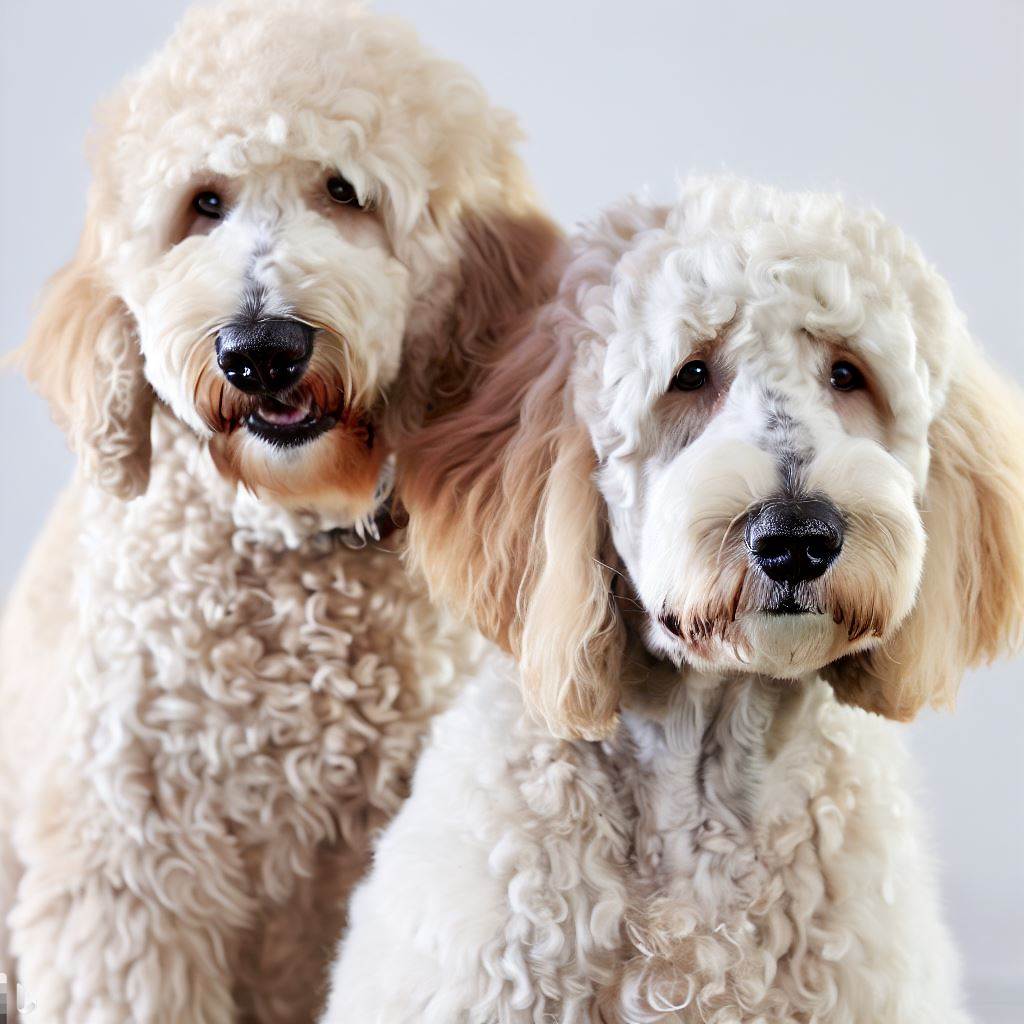Male vs Female Goldendoodle: Exploring Which Is The Best Family Dog
In the world of Goldendoodles, gender plays a fascinating role in their traits and behaviors. This article delves into the unique differences between Male vs Female Goldendoodle.
It’s not just about size; their health, temperament, and training success are all influenced by gender. For those passionate about providing the best care for their furry friends, understanding these differences is key.
So, let’s explore what makes your Goldendoodle tick!
- Key Takeaways
- Understanding Physical Differences in Male Or Female Goldendoodles
- Behavioral Differences Between A Male and A Female Goldendoodle
- Exploring Personality Differences
- Male Vs Female Goldendoodle Training
- Health Risks in Male vs Female Goldendoodles
- Life Expectancy and Overall Health
- Socialization and Temperament Differences
- Impact of Gender on Size and Coat in Goldendoodles
- Is It Better To Get A Male Or Female Goldendoodle?
- Frequently Asked Questions
Key Takeaways
- Male Goldendoodles are usually taller, heavier, and bulkier than females, especially in Standard Goldendoodles.
- Both males and females have different health risks related to their reproductive systems, with females at risk of breast cancer and males at risk of prostate problems.
- Hormonal changes during the teenage period can cause both males and females to exhibit humping behavior, which can be managed through positive reinforcement and training.
- Both male and female Goldendoodles are highly intelligent and easy to train, with no significant difference in trainability between the two genders.
Understanding Physical Differences in Male Or Female Goldendoodles
When it comes to physical differences in Goldendoodles, males dogs are generally taller, heavier, and bulkier than their female dog counterparts, particularly in the standard breed size. These physical distinctions, however, don’t affect the grooming requirements for male vs female Goldendoodles. Both sexes need regular, thorough grooming to maintain their coat’s health and appearance.
Hormones also play a vital role in the physical development of Goldendoodles. During adolescence, hormonal changes can lead to differences in behavior and physical traits. It’s important to understand these changes to provide the best care for your Goldendoodles.
Behavioral Differences Between A Male and A Female Goldendoodle
He’s noticed that hormonal changes during adolescence can lead to both male and female Goldendoodle pups displaying humping behavior. This stems from the hormonal influences on behavior in both genders of this breed. But don’t worry, this is a manageable behavior!
- Implement positive reinforcement training to discourage humping at inappropriate times.
- Provide plenty of physical and mental stimulation to keep your Goldendoodle engaged.
- Neutering or spaying can also help mitigate this behavior.
- Consult with a professional dog trainer or a veterinarian if needed.
Addressing and managing humping behavior in Goldendoodles is not just about controlling the actions of your pet. It’s about understanding their needs and helping them navigate their hormonal changes. It’s about love, patience, and care.
Exploring Personality Differences
Diving into the varied personalities, it’s clear that both male and female doodles are known for being friendly and loving companions, with no significant difference in their overall temperaments.
However, the impact of gender on play style can be noticeable. Males often play in a more physical manner, while females demonstrate a more calculated play style. They’re all charming in their unique ways!
Differences in territorial behavior between males and females are also noteworthy. Males, particularly if not neutered, may display more territorial marking. Females can be territorial but are generally less likely to mark.
It’s important to understand these nuances to provide the best care for these lovable pets. Remember, every doodle is unique, and these are general observations, not hard rules.
Male Vs Female Goldendoodle Training
In terms of training, both male and female pups show great intelligence and eagerness to learn, making it a pretty even playing field. However, they might have some potty training differences.
Male Goldendoodles might mark their territory, which can lead to indoor accidents if not adequately addressed. Females might take a bit longer to potty train due to their smaller size.
When it comes to training for specific tasks, both genders excel. They’re eager, quick learners with the patience to focus on tasks. They’re known for:
- Eager to please nature, making them responsive to commands
- High intelligence, allowing for complex task learning
- Gentle temperament, making them great service dogs
- Quick adaptability, useful in various working roles
Health Risks in Male vs Female Goldendoodles
There’s a distinct array of health risks that can potentially affect male and female Goldendoodles. These risks primarily relate to their respective reproductive systems. Females can potentially develop mammary cancer, while males may face prostate issues. Regular vet check-ups are crucial in catching these conditions early.
But health risks aren’t just limited to reproductive issues. Goldendoodles’ luscious locks, adored by many, require specific maintenance. Without proper grooming, both male and female Goldendoodles can suffer from skin infections and matting. Regular brushing, bathing, and professional grooming every few weeks can keep their coat healthy.
Also, let’s not forget about diet and exercise to prevent obesity. Indeed, keeping a Goldendoodle healthy isn’t a walk in the park, but the joy they bring is worth every effort!
Life Expectancy and Overall Health
Despite the potential health risks, both male and female Goldendoodles generally enjoy a similar life expectancy and overall good health with proper care and regular check-ups. Their high spirits and adorable features can’t help but melt hearts, while their intelligence and friendly disposition make them a delight to be around.
- Regular exercise keeps them physically fit and mentally stimulated.
- Balanced nutrition supports their growth and overall health.
- Regular grooming maintains their coat’s health and appearance.
- Routine vet check-ups help detect any potential health issues early.
Gender differences in life expectancy aren’t significant, but what truly matters is the love, care, and attention you provide. It’s a privilege to share life with these amazing canines, and they’ll reward you with unconditional love and unwavering loyalty.
Your Goldendoodle’s well-being is in your hands, make it count!
Socialization and Temperament Differences
Both male and female pups of this breed are known for their friendly and social temperament. It’s essential to start socializing them early to ensure they grow up to be well-behaved dogs.
Early socialization techniques for Goldendoodle puppies involve exposing them to a variety of people, environments, and situations. This helps them learn to handle new experiences with confidence. Regular playdates with other dogs, visits to different locations, and gentle handling by various people are all key components of effective socialization.
Dog sociability: the 11 factors together accounted for 8.3% of the total variance in this trait. Four factors had significant associations after the Bonferroni correction: older dogs were less sociable towards other dogs than younger dogs; we found higher sociability in females than in males, and in dogs acquired between 2–12 weeks of age, than in dogs acquired at older ages.
National Library of Medicine
Training sessions should be fun and rewarding to foster their natural intelligence and eagerness to please. This approach not only ensures a well-behaved Goldendoodle but also nurtures their innately sociable nature. It makes them the perfect companion for those dedicated to serving others.
Impact of Gender on Size and Coat in Goldendoodles
When it comes to size and coat, male pups typically outgrow females, becoming taller, heavier, and bulkier, especially in Standard breeds. This impact of gender on growth rate in goldendoodles is interesting yet not absolute, as factors like diet and genetics also play a role.
However, noticeable differences in coat texture between male and female goldendoodles aren’t as apparent. Both genders flaunt a beautiful array of curls and waves that are equally soft and fluffy. Regardless, here are a few intriguing points:
- Males tend to grow faster and larger, with an imposing stature.
- Females might mature quicker, displaying adult behaviors earlier.
- Both genders need regular grooming to maintain their coat’s brilliance.
- Despite size differences, both genders have equally loving hearts.
Is It Better To Get A Male Or Female Goldendoodle?
When it comes to choosing between a male or female Goldendoodle, there is no right or wrong answer. It ultimately depends on personal preference and what you are looking for in a furry companion. The breeder can provide valuable insights into the different personality traits exhibited by male and female Goldendoodles. Both genders can be equally affectionate and loving towards their owners. However, it is important to consider that male Goldendoodles tend to be slightly larger than their female counterparts. If you are seeking a bigger dog, a male Goldendoodle may be a better fit for you.
On the other hand, if you prefer a smaller and more delicate dog, a female Goldendoodle might be the perfect choice. Additionally, it is worth noting that the male Goldendoodles have a greater chance of inheriting the curly coat from the poodle parent, which can be desirable for those wanting a hypoallergenic pet. Ultimately, a happy and healthy Goldendoodle depends more on the breeder and how well they have cared for the puppies rather than their gender. So, whether you choose a male or female Goldendoodle, rest assured that you are bringing home a loyal and affectionate companion that will fill your life with love and joy.
Frequently Asked Questions
What Are the Common Health Issues That Goldendoodles Can Be Prone To, Regardless of Their Gender?
Goldendoodles can face some health issues, regardless of gender. These include hip dysplasia, a common canine condition, and certain allergies. It’s not uncommon for a Goldendoodle to have allergies, making regular vet check-ups essential.
Genetic testing can help identify potential health problems early. The love for these furry pals means ensuring they’re healthy and happy, staying informed about their breed-specific conditions, and taking proactive steps for their well-being.
What Are the Recommended Exercises for Goldendoodles to Keep Them Physically and Mentally Stimulated?
They’d recommend agility training for Goldendoodles to keep them physically fit and mentally sharp. It’s an exciting way to bond and it enhances their problem-solving skills.
Swimming lessons are also great for these dogs. It’s a low-impact exercise that’s gentle on their joints and great for their cardiovascular health. Plus, Goldendoodles naturally love water. So, it’s not just exercise, it’s fun too!
They’d recommend agility training for Goldendoodles to keep them physically fit and mentally sharp. It’s an exciting way to bond and it enhances their problem-solving skills.
Swimming lessons are also great for these dogs. It’s a low-impact exercise that’s gentle on their joints and great for their cardiovascular health. Plus, Goldendoodles naturally love water.
So, it’s not just exercise, it’s fun too!
What Specific Diet Should Goldendoodles Follow for Optimal Health?
For optimal health, Goldendoodles should have a balanced diet tailored to their size, age, and activity level. They’re prone to food allergies, so it’s essential to monitor their reaction to new foods. Portion control is also crucial to prevent obesity.
High-quality dog food, rich in protein and low in fillers, is recommended. Veggies and fruits can be added for extra nutrients. Always consult a vet for personalized advice.


